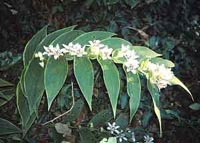Resource Library
Plant of the Week: Toadlily
The University of Arkansas System Division of Agriculture does not promote, support or recommend plants featured in "Plant of the Week." Please consult your local Extension office for plants suitable for your region.
Plant of the Week
Toadlily
Latin: Tricyrtis hirta

Sitting here at my desk in the early morning light examining the orchid-like flowers of the toadlily, it’s easy to see why gardeners are attracted to it. But it’s less apparent why an amphibian nickname stuck like so many warts to such a lovely flower.
Toadlily. What a name! Like the old saw that you can’t tell a book by its cover, don’t be fooled by the off-putting name of this fall-blooming perennial. This plant is a real charmer and well worth adding to any shade garden.
Toadlily, Tricyrtis hirta, is one of a dozen species of Asian herbs of the lily family that are found in the Himalayas, China and Japan. This species grows 2-3 feet tall with gracefully arching stems arising from an underground root system. It has 4-inch long clasping leaves that are covered with a coat of fine hairs, hence the species name, which means "hairy."
A variegated form is available with each leaf delicately edged with an eighth-inch halo of yellow.
The genus name Tricyrtis is from Latin and translates as "three convexities." It refers to the three match-head sized swollen nectary glands at the base of each flower. The flowers are borne singly along the stem, where each of the alternate leaves attaches to the stem.
Established toadlilies may have as many as two dozen of these 2-inch wide flowers splayed out along the stem when they come into bloom in early October.
Individual toadlily blooms have six petals that are splattered with brownish purple blobs on a white background, giving an overall lavender effect. It’s from these spots that some English gardener made the connection with toads and burdened the lovely plant with its unfortunate moniker.
Above the petals, the anthers extend outward and surround the three-branched stigma, giving the sexual part of the flower the look of the octopus ride at the county fair, but of course somewhat smaller. If pollination occurs early enough before frost, an erect capsule will form.
Tricyrtis seems to be one of those plants that got misplaced in the plant shuffle of the 20th century but seems to have been recently rediscovered. While Bailey and other garden writers described it almost 100 years ago, nobody seemed to carry it until recent years. About 1990, Wayside gardens began featuring the plant, and today it’s fairly common in garden centers and nurseries. Dan Heims, a West Coast propagator, lists almost 40 cultivars of the various species.
Heims, who spoke at the 2000 Arkansas Flower and Garden Show, is one of a select group of serious plantsmen who have been traveling to Japan to acquire new and interesting plants from Japanese specialty nurseries. He tells of the Gotemba Nursery in Japan where hundreds of different toadlilies can be purchased by the rabid collector for prices up to $150 per plant.
Heims’ nursery specializes in tissue culture propagation and has introduced some of the best new types and is making them available to American nurserymen.
Toadlilies must be grown in the shade. They are excellent companion plants to hostas and other inhabitants of deep shade. Fertile, well drained, uniformly moist organic soils are most to their liking, but they will tolerate lesser soils so long as they don’t contain too much clay. Extended droughts will cause tip and marginal leaf burning. While the foliage will die with the first hard freeze, they are perfectly winter hardy as far north as Chicago. New plants can be had by springtime division or by terminal cuttings taken in the spring from new growth. Slugs occasionally mar the beauty of the foliage but are not usually serious.
By: Gerald Klingaman, retired
Extension Horticulturist - Ornamentals
Extension News - October 19, 2001
The University of Arkansas System Division of Agriculture does not maintain lists of retail outlets where these plants can be purchased. Please check your local nursery or other retail outlets to ask about the availability of these plants for your growing area.